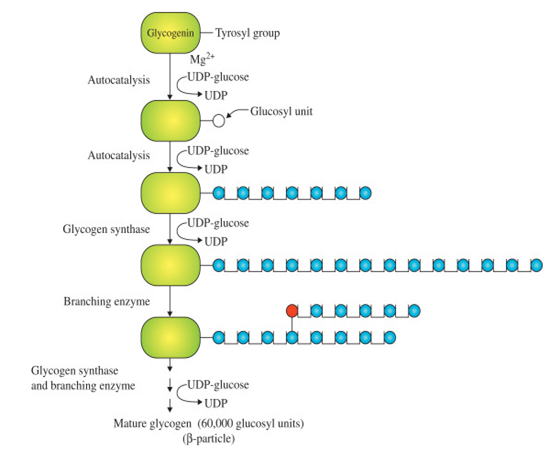| Identification | More | [Name]
GLYCOGEN | [CAS]
9005-79-2 | [Synonyms]
D-(+)-GLYCOGEN
GLYCOGEN
GLYCOGEN, BEEF
GLYCOGEN, D-(+)
GLYCOGEN, EX BOVINE LIVER
GLYCOGEN EX OYSTER
GLYCOGEN EX RABBIT LIVER
GLYCOGEN (FROM OYSTERS)
GLYCOGEN (MAMMALIAN LIVER)
GLYCOGEN, MUSSEL
GLYCOGEN OYSTER
GLYCOGEN OYSTERS
animalstarch
liverstarch
lyoglycogen
GLYCOGEN TYPE IX FROM BOVINE LIVER
GLYCOGEN TYPE III FROM RABBIT LIVER
GLYCOGEN TYPE XI FROM OYSTERS
GLYCOGEN FROM CREPIDULA FORNICATA (SLIPPER LIMPET), TYPE VIII
GLYCOGEN TYPE II FROM OYSTER | [EINECS(EC#)]
232-683-8 | [Molecular Formula]
(C6H10O5)n | [MDL Number]
MFCD00081547 | [Molecular Weight]
666.58 | [MOL File]
9005-79-2.mol |
| Chemical Properties | Back Directory | [Definition]
A glycose polysaccharide, the storage carbohydrate of the animal organism, found especially in the liver and rested muscle. | [Appearance]
White to off-white powder | [Melting point ]
270-280 °C (dec.)
| [alpha ]
D25 +196 to +197° | [density ]
1.629 g/cm3(Temp: -5 °C) | [storage temp. ]
2-8°C
| [solubility ]
H2O: 20 mg/mL, clear to hazy, faintly yellow
| [form ]
liquid | [color ]
Off-white powder | [Odor]
Odorless | [biological source]
rabbit liver | [optical activity]
+191~+200 | [Water Solubility ]
Soluble in water | [Merck ]
4496 | [LogP]
-5.590 (est) | [Uses]
glycogen is a skin-conditioning agent. It is a high molecular-weight polymer distributed through the cell protoplasm. | [CAS DataBase Reference]
9005-79-2(CAS DataBase Reference) | [EPA Substance Registry System]
9005-79-2(EPA Substance) |
| Safety Data | Back Directory | [Risk Statements ]
R36/37/38:Irritating to eyes, respiratory system and skin . | [Safety Statements ]
S24/25:Avoid contact with skin and eyes .
S26:In case of contact with eyes, rinse immediately with plenty of water and seek medical advice . | [WGK Germany ]
3
| [RTECS ]
MC2700000
| [F ]
3-10 | [TSCA ]
Yes | [HS Code ]
39139000 |
| Hazard Information | Back Directory | [Chemical Properties]
White to off-white powder | [General Description]
Glycogen is a branched polymer of glucose synthesized by animal cells for energy storage and release. It is constructed of predominantly α1→4 glycosidic bonds with branches created through α1→6 glycosidic bonds. | [Biochem/physiol Actions]
Glycogen from rabbit liver helps in maintaining blood glucose levels by regulating the release of glucose in between meals. It also provides energy during sudden, strenuous activity. Two important areas of glycogen storage are the liver and skeletal muscle. | [Synthesis]
Glycogen synthesis occurs in the cytoplasm and can be divided into the following four steps:
(1) Glycogenesis begins with the phosphorylation of glucose by glucokinase in the liver and by hexokinase in muscle and other tissues.
(2) Glucose-6-phosphate is then converted into glucose-1-phosphate by phosphoglucomutase, a reaction similar to that catalysed by phosphoglycerol mutase.
(3) Glucose-1-phosphate is converted into uridine diphosphate (UTP)-glucose, the immediate precursor of glycogen synthesis, by reaction with uridine triphosphate (UTP). This reaction is catalysed by glucose 1-phosphate uridylyltransferase (or UDP-glucose pyrophosphorylase).
(4) Finally, the glucosyl residue at the C-1 position of UDP-glucose is added to the tyrosyl group at position 194 of glycogen protease in an Mg2+-dependent autocatalytic reaction. Glycosidases similarly extend the glucan chain by α(1→4) glycosidic bonds by adding 6 to 7 glucosyl units, using UDP-glucose as the substrate, in an autocatalytic reaction. The glucan primer of glycogen proteins is elongated by glycogen synthase using UDP glucose. Initially, the glycogenin primer and glycogen synthase are strongly bound using a 1:1 complex. As the dextran chain grows, glycogen synthase separates from glycogen.
 | [Purification Methods]
A 5% aqueous solution (charcoal) of D(+)-glycogen is filtered, and an equal volume of EtOH is added. After standing overnight at 3o the precipitate is collected by centrifugation, washed with absolute EtOH, then EtOH/diethyl ether (1:1) and diethyl ether, and dried. [Sutherland & Wosilait J Biol Chem 218 459 1956.] |
|
|